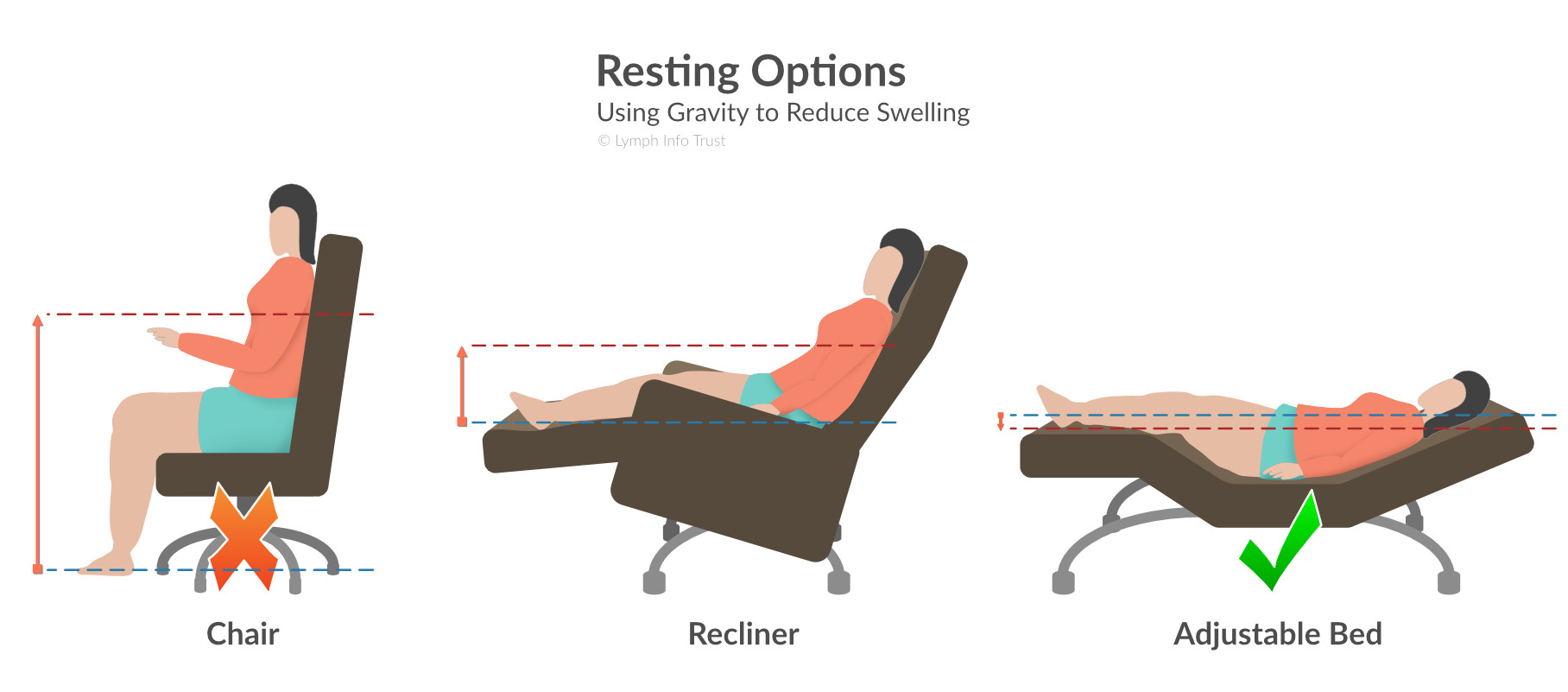Combined Decongestive Therapy
Combined Decongestive Therapy (CDT) is the gold standard treatment for lymphoedema and is also recommended for lipoedema. Ask your therapist if they are qualified in combined decongestive therapy.
Combined decongestive therapy consists of four components:
Compression
Compression is essential to stopping the swollen part of the body from refilling with fluid. Skin has a certain amount of stretch. It acts as its own compression sleeve, but loses its holding strength the more it is stretched.
Compression works by pushing against the muscles. This helps the body to pump lymph fluid.
The two treatment stages are:
- Reduction Stage
- Maintenance Stage
Reduction Stage with Bandages & Wraps
To reduce swelling, more compression is required. Compression can be achieved with tight bandages or adjustable wraps. Bandages and wraps must be applied by a trained therapist.
Maintenance Stage with Compression Garments
With the body part reduced in size, the focus turns to keeping the swelling down.
During the maintenance stage, the patient wears a compression garment. The garment looks like a thick stocking or sock.
Compression Garments
Compression garments help prevent the limb from refilling with fluid.
Put the garment on first thing in the morning while the affected limb (arm or leg) is least swollen.
Unless used for scar therapy, you won't need to wear the garment at night time.
Putting Your Compression Garment On
Before putting a compression garment on:
- ensure at least one hour has passed since applying moisturiser
Note: The best time to put moisturiser on is at night time when you take the garment off to wash it. - remove any jewellery
- make sure your hands and fingernails are well cared for, and
- ensure you are, or the person helping you is, wearing rubber gloves.
Wearing rubber gloves helps to smooth out any wrinkles that might trap fluid. Gloves also protect the fabric from sharp fingernails and scratches.
To be effective, compression garments need to fit like a second skin. Ill-fitted garments can aggravate lymphoedema symptoms.
Washing Your Garment
Garments will for last up to six months if cared for. Residues of skin, ointments, dirt and dust can damage the elastic garment.
Wash used garments daily. This keeps the fabric stretchy and tight.
Wash compression garments in the washing machine on a gentle or delicate wash cycle (40 °C or less).
Use a laundry bag or pillow case to protect the garment from wear and tear in the machine.
Only use liquid detergents.
Do not use:
- washing powder
Note: Undissolved washing powder can become stuck in the fibres of the garment. - fabric softeners, nor
- shampoos.
Drying Your Garment
To dry the garment, loosely hang it away from direct sunlight.
Note: You can reduce the drying time by rolling the garment in a thick towel to remove extra moisture, but do not leave it rolled up.
Do not:
- hang the garment on a heater, nor
- dry clean the garment.
If tumble drying, use a delicate cycle and refer to the care symbols on the garment.
Garment Replacement
After six months of use, replace the garments.
Use this time to confirm your measurements with your therapist and ensure you have the right fit.
Pneumatic Compression
If compression garments have little effect, consider pneumatic compression. This is particularly important for phlebolymphoedema sufferers. With pneumatic compression the leg is placed inside a sleeve of air chambers. The air chambers inflate sequentially up the leg; preventing back-flow of fluid.
Manual Lymphatic Drainage
Manual Lymphatic Drainage (MLD) is a form of massage. It is painless, gentle, and very relaxing.
Manual Lymphatic Drainage stimulates the lymphatic system and moves lymph fluid. It is used in a lot of different ways, such as facials, sports massage, health massage and lymphoedema management.
Choose a therapist who has been trained in:
- applying manual lymphatic drainage to lymphoedema
- working with a problematic lymphatic system, and
- moving the lymph fluid past blockages.
Exercise – Stay Active
Moving your body helps your muscles pump lymph fluid through your body.
Exercise can:
- reduce your lymphoedema
- keep your bones strong
- maintain a healthy weight
Note: It may help you lose weight. - reduce stress, and
- improve your mood.
Exercise doesn’t have to include running or going to the gym.
Breathing
Deep abdominal breathing activates the diaphragmatic pump. This increases blood and lymph circulation.
Rest – Elevate Your Legs When Resting
Elevating your legs when resting assists in:
- moving blood to your heart, and
- draining lymph fluid into the lymph nodes in the back of your knees and groin.
Lymph nodes process and filter the fluid for removal from the body as urine.

Sitting upright is not an ideal resting position. This is because of the vertical distance the blood has to be pushed to reach the heart.
Recliner chairs will reduce the difference in elevation. However, the heart is still elevated well above the legs, so the legs cannot freely drain.
Note: Recliner chairs are useful if you have breathing issues or sleep apnea.
Hospital-type adjustable beds elevate both the legs and the upper body. This is ideal. With the heart at around the same elevation or slightly lower, blood and lymph drain from the legs under gravity.
IMPORTANT: Regularly change the position of your legs when resting.
Walking
When walking, calf muscles act like a pump to improve circulation of blood and lymph. Seated exercises can also help with circulation, as can ankle pumps. One minute of ankle pumps can benefit circulation for up to 30 minutes.
Keep your ankles flexible. Flexible ankles assist in calf muscle contraction.
Note: Impaired calf muscles cause feet to shuffle when walking.
Movement in General
Focus on movement, activities and general wellbeing. The more confident you are, the more active you will become. Do what you can manage, and as you get stronger you will be able to increase your exercise activities.
Recommended exercises include:
- exercising in water
The effect of compression from the water pressure improves muscle contraction.
WARNING! Do not enter the water if you have wounds or ulcers. Wounds and ulcers can become infected. - repetitive movements such as:
- walking
- cycling
- cross training, or
- light weight-training.
Talk to your therapist, or look for a physiotherapist who is trained in rehabilitating people who have suffered an illness. Lifestyle changes make a significant difference to your wellbeing, particularly if you struggle with phlebolymphoedema. These changes include:
- quitting smoking
- losing weight
- dietary changes, and
- taking up regular exercise.
Useful Links
A good place to start looking is:
- Pinc & Steel
This charity specialises in cancer rehabilitation. Pinc and Steel therapists have a good knowledge of lymphoedema.
Skincare
Skin is the largest organ in the body. One of its jobs is to protect the body from infection. Swelling stretches the skin and makes less elastic. Lymphoedema puts a lot of pressure on the skin. This can make it more difficult for the skin to protect the body from infection.
Checks
Each day, check your skin for any weak spots, and keep it clean. Clean any damaged skin with antiseptic and ensure it is covered.
Cuts, grazes, nicks, insect bites, or openings in the skin can allow bacteria into the blood stream. The lymphatic system is responsible for dealing with these infections. If the lymphatic system isn't working properly, it can become overwhelmed and fail to deal with ordinary infections.
IMPORTANT! Treat all wounds. If your condition has developed into phlebolymphoedema you will be vulnerable to wounds that must be treated. To minimise wounds and reduce the occurrence of dry cracked skin, moisturise your skin. Softened skin is less likely to crack and will help maintain a barrier against infection.
Thickened Skin
Extra protein in the tissues can lead to changes in how the skin looks and feels. The skin may become thickened and split or leak fluid.
Bandaging and compression can also rob your skin of moisture and oil, making the skin dry and fragile.
Moisturiser
Use a low-pH or pH-balanced moisturiser.
Mild emollients in the form of soap or bath oil may be used.
Do not use moisturisers that contain alcohol.
Do not use moisturisers that contain perfume.
Apply moisturiser after removing your garment before going to bed.
Drying Your Skin
Towels remove excess moisture, dead skin and essential oils. Pure cotton towels can be abrasive. Rather than wiping your skin, consider patting it dry instead.
Consider other wash cloth and towel options.
Towels and wash cloths that use bamboo fibres are ultra-soft. These towels are resistant to bacteria and less likely to cause an allergic reaction. Silk wash cloths are even softer. Muslin wash cloths and towels are also soft options.
Cellulitis
The biggest risk for anyone with lymphoedema is a cellulitis infection. If your skin feels warm or hot, red, inflamed and painful, seek medical help straight away. If your GP is unavailable, go to the Accident & Emergency department of your nearest hospital.
WARNING! See a medical professional immediately if you think you have a cellulitis infection.
Tip: With a pen or eyeliner, draw around the red outline of the infection and note the time. This will help your doctor gauge the speed at which the infection is spreading.
The risk of serious infection is why it is so important to look after your skin.













